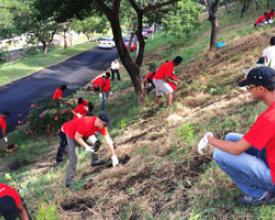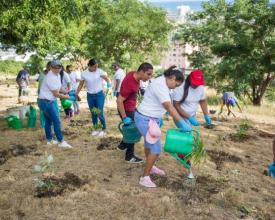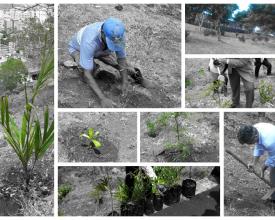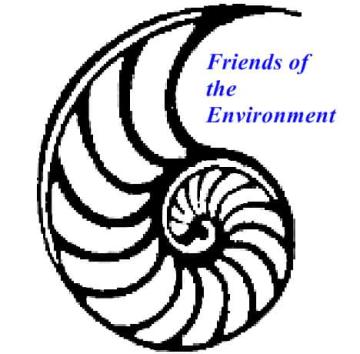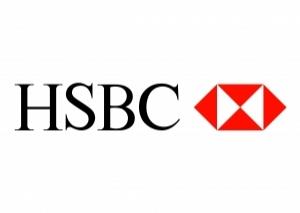
Restauración de la cubierta vegetal y los bosques autóctonos de los puntos críticos de biodiversidad de Mauricio
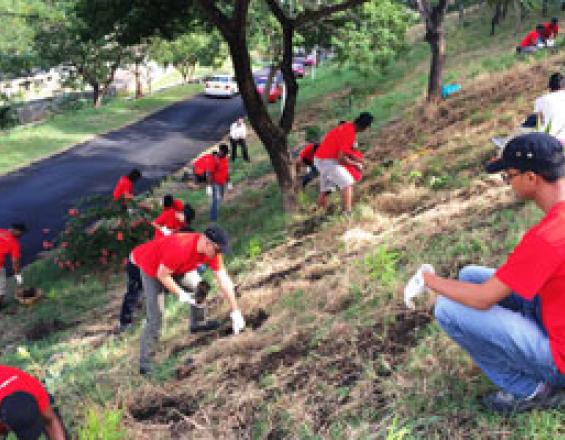
Desde 2010, 2,5 ha de Citadel y 18 ha de Petrin han sido restauradas con árboles endémicos. El objetivo de este proyecto de reforestación es conservar la biodiversidad única de Mauricio, permitir la revegetación completa de las 11 ha de Citadel, reintroducir el ecosistema endémico de Petrin, invadido por plantas exóticas, y preservar el ecosistema para que el público pueda apreciar la naturaleza. Debido a que los pastizales de Ciudadela son propensos al fuego, cada año se producen incendios que arrasan gran parte de la zona. Se crean cortafuegos añadiendo una barrera de rocas alrededor de cada planta y retirando regularmente la hierba. En Petrin se utilizan herbicidas para controlar las plantas exóticas, que son muy densas. Para reducir el riesgo de mortalidad se seleccionaron especies autóctonas adaptadas a las condiciones ambientales del lugar. Después de que se establezca una cubierta vegetal y empiecen a crecer algunas de las especies pioneras, se plantarán especies que necesiten más humedad y sombra.El ecosistema en peligro se regenerará mediante la dispersión de semillas.
Contexto
Défis à relever
- Falta de recursos especializados y de mano de obra para un mantenimiento adecuado y continuo de las zonas conservadas.
-El monumento histórico, junto con la zona restaurada de la Ciudadela, atrae a muchos turistas y al público en general, pero la zona conservada no está asegurada en caso de robos, frecuentes incendios provocados por jóvenes y daños.
- Presencia de plantas invasoras: es necesario aumentar la concienciación sobre la conservación de la biodiversidad autóctona y los efectos nocivos de las especies exóticas invasoras mediante campañas de sensibilización.
- La comunidad de sabana abierta de plantas exóticas, propensa al fuego, debe ser sustituida por un pastizal o bosque autóctono que no sea propenso al fuego, reduciendo así la erosión del suelo y la desertificación.
-Se necesita un embalse para regar las plantas con regularidad.
-Se ha producido una deforestación debido a las necesidades de desarrollo económico (economía de la caña de azúcar y desarrollo inmobiliario), lo que ha provocado que sólo quede un 2% de bosque endémico/nativo en la isla.
Ubicación
Procesar
Resumen del proceso
Para la continuidad del proyecto, necesitamos fuentes de financiación sostenibles.
Se organizan varios actos, como ceremonias de plantación de árboles y limpiezas, en los que participan las ONG y partes interesadas mencionadas. Estas actividades contribuyen a revitalizar el ecosistema de la Ciudadela y pretenden crear una zona verde pública metropolitana en el corazón de la capital para conectar a la gente con la naturaleza y fomentar una vida sana.
Cada ONG cuenta con la ayuda de distintas partes interesadas. Por ejemplo : FORENA y FOE comparten el mismo problema y el mismo éxito, teniendo como objetivo regenerar el total de 11 ha del ecosistema montañoso de Ciudadela.
Es necesario crear un enfoque holístico para este proyecto de reforestación implicando al máximo a las partes interesadas y colaborando con las ONG mencionadas.
Los interesados deben saber cómo se gasta su dinero en la reforestación de Ciudadela y Petrín.
En cierto modo, están contribuyendo indirectamente a la conservación de Ciudadela y Petrín. La protección de la naturaleza no sólo debe reflejar la labor de las organizaciones no gubernamentales, sino también la de las partes interesadas que, en cierto modo, no habrían sido posibles sin ellas.
Bloques de construcción
Actividades de reforestación de organizaciones no gubernamentales
FORENA, junto con Amigos del Medio Ambiente (FOE), dirige actualmente el proyecto "Restauración y valorización de la Ciudadela de Port Louis", dependiente de la Autoridad de Turismo, con un equipo de expertos formado por arquitectos, historiadores, arqueólogos y ecologistas de la Fundación para la Vida Salvaje de Mauricio (MWF), que prevé la restauración histórica y la valorización del patrimonio de la Ciudadela para su uso con fines turísticos, educativos y de ocio.
La FOE ha participado activamente en la organización de conferencias y seminarios de importancia medioambiental. Han renovado y ahora asumen la gestión del Museo de la Torre Martello y, a través del Heritage Trust, prosiguen la rehabilitación de cementerios. A lo largo de los años, sus miembros han participado en numerosos comités en favor del medio ambiente.
El MWF trabaja por la conservación y preservación de las especies animales y vegetales amenazadas de la nación. Colaboran con socios locales e internacionales, con el objetivo a largo plazo de recrear ecosistemas perdidos salvando de la extinción a algunas de las especies más raras y restaurando los bosques autóctonos.
Factores facilitadores
Comunicación adecuada entre ambos equipos (FORENA y FOE) ya que ambos estamos trabajando en el mismo proyecto pero en diferentes áreas asignadas de Ciudadela.
Se aplicará la misma técnica para la plantación de árboles. Si un equipo ha cambiado su metodología y utiliza una más eficiente, que transmita la información para que el otro equipo pueda utilizar el mismo método.
Compartimos el mismo jardinero, pero cada equipo tiene sus propios equipos.
Lección aprendida
Todas las organizaciones no gubernamentales mencionadas comparten el mismo objetivo, que es poder llevar a cabo la restauración a gran escala de la Ciudadela y realizar un seguimiento adecuado del bosque autóctono de Petrin. Forena actúa como enlace entre estas organizaciones y las partes interesadas para permitir una colaboración continua en favor de la naturaleza de Mauricio.
Hay varias técnicas que Forena ha adoptado de Friend of the Environment, ya que contaban con la experiencia de los ecologistas. Por ejemplo, hemos empezado a utilizar gel, que permite retener el agua y los nutrientes alrededor de la base radicular de las plantas, y también la técnica de la botella de agua, que permite un riego eficaz.
Siempre hay un buen mecanismo de coordinación entre las organizaciones cuando se produce un caso de vandalismo o un conato de incendio.
Colaboración con el sector privado para una financiación sostenible
Para la continuidad del proyecto, necesitamos una financiación sostenible. Forena colabora actualmente con Lux* Resorts and Hotels, Kolos, clubes rotarios, PWC (PricewaterhouseCoopers), Abax, IBL Together (Ireland Blyth Limited), HSBC (Hongkong and Shanghai Banking Corporation Limited) y Porlwi by nature (Ciel Group). El proyecto se inscribe en el proyecto global de regeneración de las 11 hectáreas del ecosistema montañoso, y se llevaron a cabo actividades de plantación de árboles y limpieza con las partes interesadas y sus empleados. Estas actividades apoyan la reactivación del ecosistema de Ciudadela y Petrín, la reducción de la erosión del suelo y la desertificación y permiten conectar con la naturaleza y llevar una vida sana. De este modo, las partes interesadas saben cómo se invierte su dinero en la reforestación de Citadel y Petrin, y contribuyen indirectamente a la conservación y preservación de los bosques autóctonos de Mauricio. La protección de la naturaleza no sólo debe reflejar la labor de las organizaciones no gubernamentales, sino también la de las partes interesadas, que sin ellas no habría sido posible.
Factores facilitadores
Hay que asegurarse de que se celebran reuniones periódicas con las partes interesadas y de que éstas son capaces de controlar lo que se ha hecho y lo que hay que poner en práctica sobre el terreno.
Cada parte interesada debe tener a alguien que la represente y que sirva de enlace con las organizaciones no gubernamentales, porque a veces resulta difícil organizar una reunión debido a los diferentes horarios de trabajo.
Lección aprendida
Buena colaboración de los socios por su gran interés en trabajar por el medio ambiente.
Establecer una relación formal con las partes interesadas, explicarles la finalidad y las repercusiones del proyecto.
Organizar actividades para ellos in situ, seguidas de una sesión informativa y una demostración.
Hacer un seguimiento mediante el envío de un informe de actividades de su evento y un informe anual para que los socios sigan colaborando en la consecución de la plena restauración del bosque autóctono de Ciudadela y Petrín.
Impactos
La cubierta vegetal autóctona totalmente restaurada prevista para la Ciudadela :
1) Proporciona un entorno agradable y libre de estrés para reponer fuerzas de la bulliciosa vida urbana, además de una actividad sana y pedagógica.
2) Constituye uno de los raros casos de repoblación forestal en Mauricio continental que servirá de ejemplo concreto de nuestra contribución a la reducción del exceso de dióxido de carbono en la atmósfera mediante la fijación de parte del mismo en las plantas.
3) Ayuda a la conservación de la fauna autóctona de Mauricio al reconstituir poblaciones de especies autóctonas y endémicas que antaño existían en la Ciudadela pero que fueron destruidas por el ser humano. Cabe señalar aquí que, de todos los países del mundo, Mauricio tiene una de las biodiversidades autóctonas más dañadas, con muchas de sus especies únicas amenazadas de extinción.
4) Reduce la erosión del suelo y la desertificación, así como los riesgos directos a los que se exponen las personas y las propiedades debido a los incendios esporádicos que azotan las zonas cada año, sustituyendo una comunidad de plantas exóticas similar a una sabana abierta y propensa a los incendios por un pastizal o bosque autóctono no propenso a los incendios.
5) Aumenta la concienciación sobre la necesidad de conservar la biodiversidad autóctona y los efectos nocivos de las especies exóticas invasoras mediante la educación medioambiental en las escuelas.
6) Facilita el ecoturismo con visitas a esta zona verde restaurada junto a la Ciudadela, un monumento histórico.
Beneficiarios
Los habitantes de la capital podrán conectar con la naturaleza a través de la zona verde restaurada de la Ciudadela. Creación de empleos verdes (mantenimiento y deshierbe). Los turistas conocerán tanto el fuerte histórico como su biodiversidad autóctona.
Objetivos de Desarrollo Sostenible
Historia

No podemos negar que los efectos indeseables de la deforestación y el calentamiento global se dejan sentir más que nunca y ya están cambiando el mundo en términos de vidas humanas y pérdidas de propiedades y producciones agrícolas. Esta tendencia va a acelerarse a medida que se sigan destruyendo más bosques primarios y se sigan vertiendo a la atmósfera millones de toneladas diarias de dióxido de carbono debido a las actividades humanas. Al mismo tiempo, la biodiversidad mundial está disminuyendo a un ritmo alarmante, con el planeta entrando en la sexta extinción masiva, y está causada por una sola especie: nosotros.
La vegetación autóctona que una vez existió en Ciudadela fue destruida por los humanos hace unos siglos. En la actualidad, la biodiversidad de Ciudadela está compuesta en su mayor parte por especies exóticas, incluidas algunas plantadas, sin duda como resultado de la deforestación temprana y de los incendios regulares que arrasan gran parte de la zona cada año.
Aunque nunca se describió su vegetación original, es posible hacerse una idea de cómo podría haber sido comparándola con la de otros lugares de Mauricio con condiciones similares. Éstas incluyen principalmente el clima (precipitaciones y temperatura) y el suelo, y en menor medida el aspecto y la inclinación, así como la distancia a la costa. Lo más probable es que la vegetación original de Ciudadela fuera un bosque seco de árboles relativamente achaparrados de unos 4 a 6 m de altura, con raras plantas emergentes, que crecían a baja densidad y eran ricos en palmeras, pinos tornillo y algunos árboles y arbustos de madera dura. Las plantaciones se están realizando de forma que se parezca lo más posible a un entorno natural, evitando, por ejemplo, la plantación en hileras rectas.
Desde 2010, Forena, principalmente en colaboración con sus socios Amigos del Medio Ambiente, el Programa de Pequeñas Subvenciones del FMAM, el PNUD y la Autoridad de Turismo, ha conseguido restaurar cerca de 3 ha de la Ciudadela. Nuestro objetivo es la restauración a gran escala de la Ciudadela, que tiene 11 ha, mediante el restablecimiento de una cubierta vegetal autóctona adecuada que respete el patrimonio histórico nacional. Esto no sólo contribuirá a la creación de un bosque sostenible y un sumidero de carbono en el contexto del alarmante cambio climático, sino que también mejorará la zona turística de Port Louis y ayudará a crear conciencia sobre nuestra biodiversidad única, notoriamente una de las más amenazadas del mundo.
